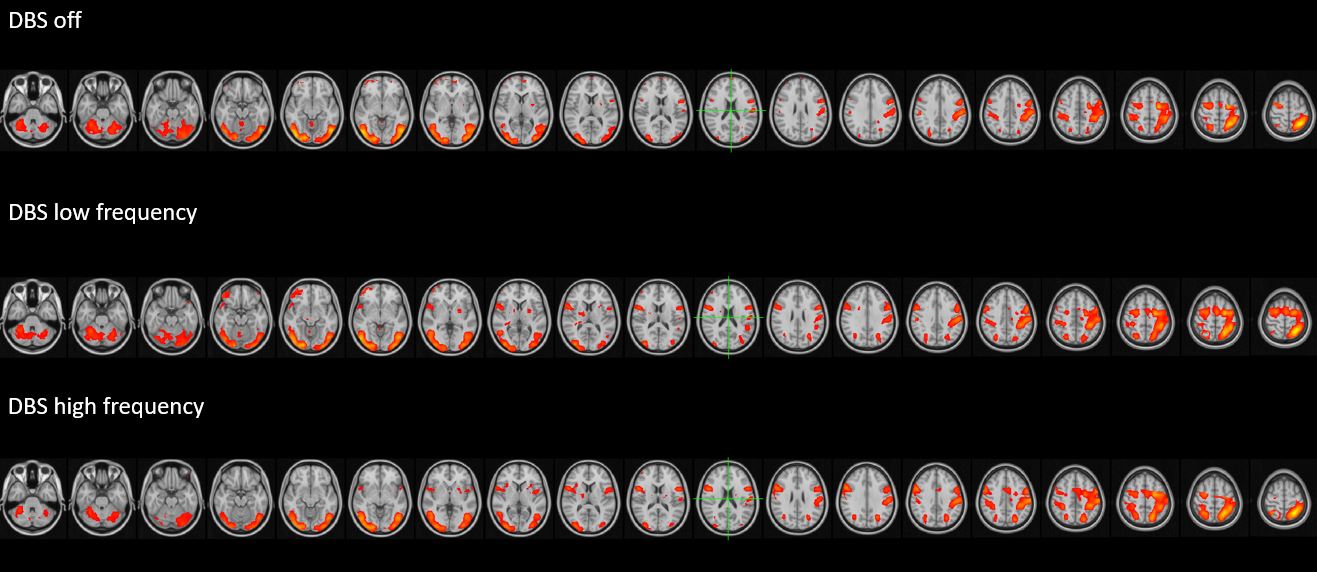Category: Parkinson's Disease: Neuroimaging
Objective: The study aimed to investigate the impact of deep brain stimulation (DBS) at varying frequencies on brain activation patterns during a motor (force-tracking [FT]) task using functional Magnetic Resonance Imaging (fMRI) in Parkinson’s disease (PD) patients with DBS implants in the subthalamic nucleus (STN).
Background: While DBS targeting the STN (STN-DBS) offers promising therapeutic benefits for managing motor symptoms in PD [1], the effects of different DBS stimulation frequencies on the brain networks governing motor control remain uncertain. Prior research has shown that fMRI can effectively study how the brain reacts to varying DBS stimulation frequencies [2, 3]. However, no studies have investigated the effect of frequencies on activation patterns during a motor task. Our study aimed to elucidate the impact of STN-DBS frequencies on brain activation patterns during a motor task using fMRI.
Method: We investigated brain responses during a FT task across 9 PD patients with bilateral STN-DBS in a 3T MRI scanner. Images were acquired with BOLD-weighted gradient-echo echoplanar scan (TR/TE = 2800/2.9 ms; slice thickness = 4mm) under three STN-DBS conditions: DBS turned off, DBS turned on at the high (optimal) frequency, and DBS turned on at a lower (40 Hz) frequency. Subsequently, fMRI analyses were conducted using SPM12, with results significant at p<0.05 (family-wise error, FWE-corrected).
Results: During the FT fMRI task, the analysis revealed extensive activation across motor, parietal, temporal, occipital, and cerebellar brain regions for all three DBS conditions [Figure 1]. While both high- and low-frequency stimulation engaged the basal ganglia-thalamo-cortical network, an intriguing finding was that low-frequency stimulation and DBS-off conditions recruited frontal brain areas, which was not observed with high-frequency stimulation.
Conclusion: These findings highlight the complexity of the brain’s response to different DBS stimulation frequencies and conditions. However, the findings are based on a relatively small sample size. Larger sample studies are needed to robustly delineate the complex neural mechanisms underlying the effects of DBS frequencies.
fMRI activation patterns in STN-DBS PD patients
References: 1. Groiss SJ, Wojtecki L, Sudmeyer M, Schnitzler A. Deep brain stimulation in Parkinson’s disease. Ther Adv Neurol Disord. 2009;2(6):20-8. Epub 2010/12/25. doi: 10.1177/1756285609339382. PubMed PMID: 21180627; PubMed Central PMCID: PMCPMC3002606.
2. DiMarzio M, Madhavan R, Hancu I, Fiveland E, Prusik J, Joel S, et al. Use of Functional MRI to Assess Effects of Deep Brain Stimulation Frequency Changes on Brain Activation in Parkinson Disease. Neurosurgery. 2021;88(2):356-65. Epub 2020/09/29. doi: 10.1093/neuros/nyaa397. PubMed PMID: 32985661.
3. Shen L, Jiang C, Hubbard CS, Ren J, He C, Wang D, et al. Subthalamic Nucleus Deep Brain Stimulation Modulates 2 Distinct Neurocircuits. Ann Neurol. 2020;88(6):1178-93. Epub 2020/09/21. doi: 10.1002/ana.25906. PubMed PMID: 32951262; PubMed Central PMCID: PMCPMC8087166.
To cite this abstract in AMA style:
A. Vijayakumari, C. Piccinin, J. Alberts, P. Bhattacharya, M. Lowe, B. Walter. STN-DBS Frequency Effects in Parkinson’s: An fMRI Study [abstract]. Mov Disord. 2024; 39 (suppl 1). https://www.mdsabstracts.org/abstract/stn-dbs-frequency-effects-in-parkinsons-an-fmri-study/. Accessed May 8, 2025.« Back to 2024 International Congress
MDS Abstracts - https://www.mdsabstracts.org/abstract/stn-dbs-frequency-effects-in-parkinsons-an-fmri-study/

